Volzhanka and its cultivation

Perhaps, in every garden there is a place that is not suitable for growing berries and vegetables, but without planting it looks gloomy and uncomfortable. To refine and decorate such a space, they often use various flowering plants that are unpretentious in care and safe for humans. An excellent option for this design is Volzhanka.
The plant will not only decorate the unsightly corner of the site, but will also help decorate the space along the fence, as well as create a dense bushy fence in its absence. Let's take a closer look at the characteristics of this plant, the features of its planting and subsequent care, and also get acquainted with the options for using Volzhanka in the landscape design of the garden.
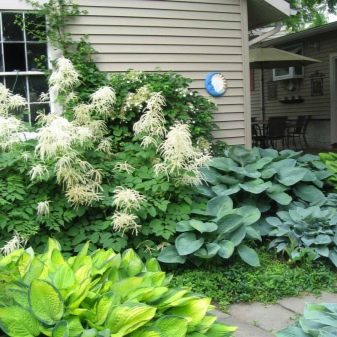
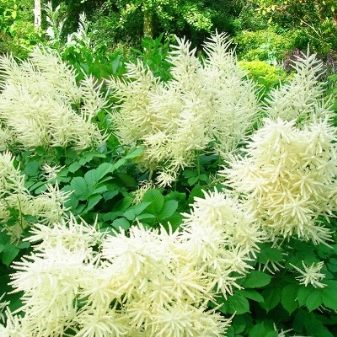
Description
Volzhanka dioecious, also known as aruncus, is a tall shrub with spreading branches and white fluffy inflorescences that are located at the end of each branch. The length of the inflorescences can reach 60 centimeters. The leaves have a rich dark green color, and in shape they resemble graceful feathers with a small jagged edge. The plant is known for its long flowering period (about a month), which is accompanied by a delicate honey aroma and allows you to enjoy Volzhanka on warm summer evenings. The plant is perennial and will be a pleasant neighbor on your site for many years, so you need to take care of a comfortable location for it.
Since Volzhanka does not like extreme heat and does not tolerate constant exposure to direct sunlight, we recommend placing the shrub in a shady corner of your garden. In addition, when choosing a suitable place for growing Volzhanka, the size of the plant must also be taken into account. For example, depending on the variety, the height of the shrub can reach 2 m, and the diameter - 1.5 m.
It should also be borne in mind that the roots of the plant do not go deep into the ground, but grow almost on the surface, which also contributes to the rapid spread of shrubs and the formation of thickets.

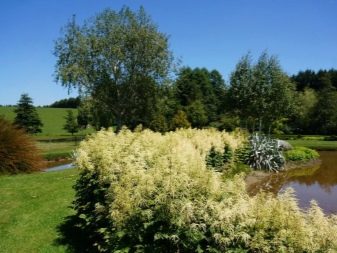
Popular species and varieties
There are several varieties of Volzhanka, each of which can be easily identified by one or another characteristic feature. Besides, a particular species can also be classified into several distinct varieties.
Dioecious
Volzhanka dioecious is also called ordinary, since it is the most common and familiar species for many gardeners. The plant is found mainly in the European part of Russia, as well as in the forests of the Caucasus. The flowering of Volzhanka vulgaris lasts only 2-3 weeks, the inflorescences are impressive in size - up to 60 cm in length, and the tart aroma attracts insects. Despite the volume of the bushes, the plant does not differ in the speed of propagation, so you should not expect that Volzhanka will grow on your site on its own during the season, most likely it will take several years.
Let's consider in more detail the varieties of Volzhanka vulgaris.
- "Kneffi" - the bushes have a height of only 60 centimeters, as well as an average density of foliage, which makes it look slightly drooping.
- "Horatio" - bushes of medium size, the height of which varies within 70 cm, the stems are characterized by a reddish tint.
- "Misty Lace" - the plant is also of medium size, and the foliage looks like fern leaves. The flowers have a characteristic shade of ivory.
- "Perfection" - perhaps this is the smallest variety of Volzhanka, since the height of the bush can reach only 20 cm, which does not in any way affect the duration of growth and the flowering period.
- "Fountains" - the most massive variety of Volzhanka. The height of the bushes reaches 2 meters, and a feature is beautiful foliage with openwork edging.
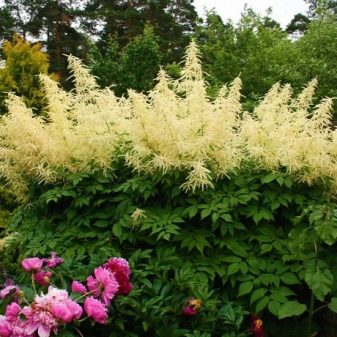

Cocortical
The bushes of Volzhanka kokoryshilistnaya are very small in size: their height reaches only 30 cm, which makes them ideal for landscape design and gardening. With the onset of autumn, the rich green color of the foliage changes its shade to burgundy, and a little later to bronze, due to which the plant looks completely different, and the flower corner of the garden plays with new colors.
The inflorescences are characterized by a creamy shade and short length, which is characteristic of such a small size of the bush itself. The flowering period falls in mid-summer and lasts only a couple of weeks, and the rest of the days, the culture decorates the garden exclusively with the appearance of its foliage. This species does not need care and feeding, it can grow like a weed, but with one condition - it needs moist soil. Therefore, the named plant can also be observed quite often near rivers, streams and other bodies of water.
Kokoryshilistnaya Volzhanka is also known for its most popular variety - "Noble Spirit", which is characterized by the height of the bushes within 25 cm, as well as more fluffy inflorescences. Often this particular variety is used to form borders in landscape design.
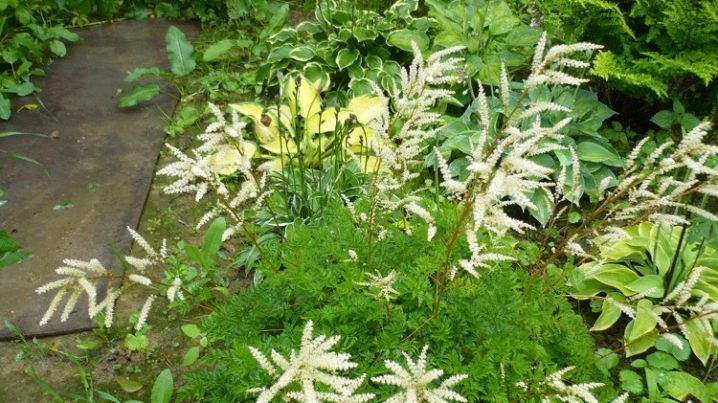
Lesnaya
This variety of Volzhanka is characterized by the maximum height of the bushes, as well as the rougher outlines of the deciduous part of the plant and its density. Besides, forest volzhanka has a shortened root system, which contributes to a more rapid growth of bushes and the spread of culture throughout the territory. During the flowering period, lush inflorescences are formed on the branches, the length of which does not exceed 40 cm. This stage stretches throughout the summer - the inflorescences appear in late May or early June, and the seeds ripen only by September.
All this time, the forest volzhanka will delight you with the attractive aroma of its flowers. This species is characterized by high resistance to severe frosts, which allows the plant to easily endure all the features of winter bad weather, and in the spring, as if nothing had happened, again fascinate others with its blossoming beauty. Most often, this type of Volzhanka can be found in the eastern Chinese regions, as well as in Siberia.
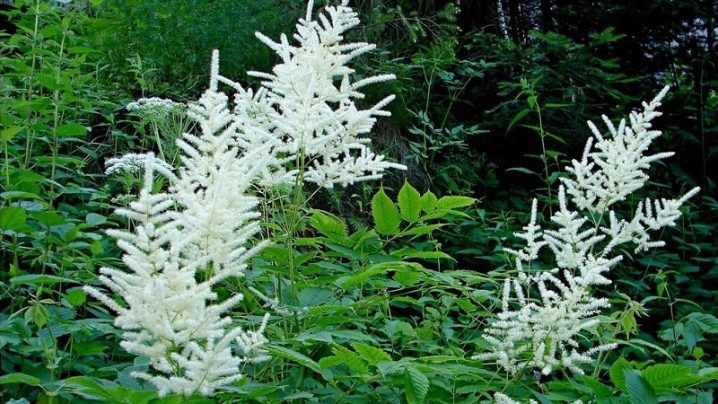
Landing
The process of planting Volzhanka must be taken responsibly, since the development of the plant is influenced not only by subsequent care, but also by the choice of location. As previously stated, it is better to give preference to shady areas located near any body of water or irrigation source. If this is not possible, it is recommended to regularly provide moisture to the soil in which Volzhanka grows. Avoid direct sunlight on the plant, since ultraviolet radiation adversely affects the foliage and leads to its burnout, and also significantly reduces the rate of development of the bush. The most suitable place for planting Volzhanka will be an area on which the sun shines only from morning until lunchtime, thus the plant will receive everything it needs for healthy growth, avoiding the most active and aggressive effects of ultraviolet radiation.
It is also necessary to provide the Volzhanka with privacy and avoid any close proximity to other plants. The thing is that the culture in question is very fond of the nutrients contained in fertile soil, and may even conflict with neighbors. It is also recommended to avoid subsequent transplants as much as possible, since the plant is very difficult to tolerate them. When planting, you can additionally fertilize the soil using about 2 kg of humus, as well as nitrophosphate in the amount of 30 g.This top dressing will be enough for the whole season, it will provide the Volzhanka rhizome with the necessary immunity to easily endure winter.
In the process of landing, you should adhere to the following sequence of actions:
- the first step is to prepare a hole for the plant;
- then you need to mix the soil with top dressing;
- completely fill the hole with water and let it soak;
- then place the seedling in the hole and cover it with soil.
Planting is best done in spring, with the onset of stable warm weather.
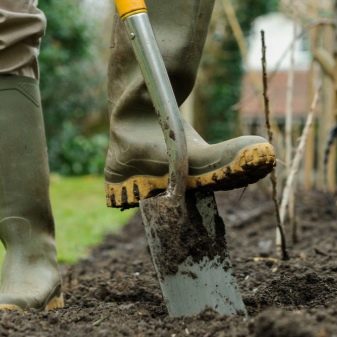
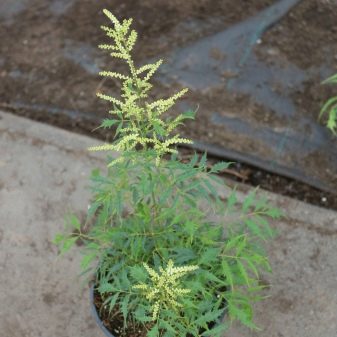
Care
After planting, it is necessary to provide young plants with the necessary care so that they grow stronger and do not die in the open field.
Watering
As you know, due to the intensity of growth, Volzhanka is very fond of moisture, therefore watering is an integral part of plant care. In springtime, as well as in hot weather, you may need up to 4 buckets of water to replenish lost fluid. Each time after watering, you should loosen the soil, and also remove weeds that can affect the health of the shrub.
The frequency of watering should be adjusted based on the condition of the soil. For example, after heavy rainfall, Volzhanka does not need moisture, and during the sultry heat, it is necessary to introduce moisture into the soil daily.
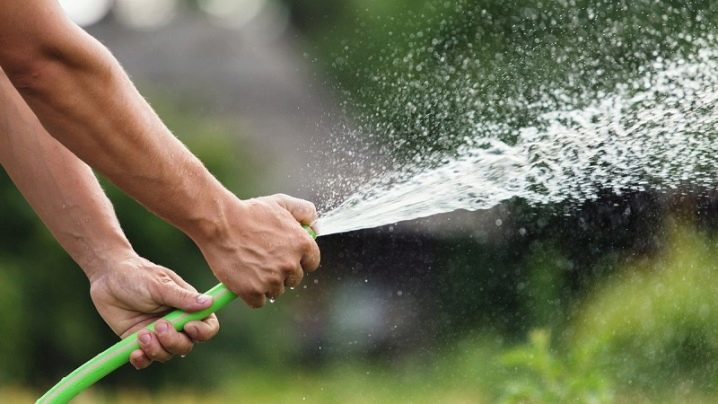
Top dressing
Organic additives have a very positive effect on the development of the plant, strengthening its immunity, making it resistant to various external influences, diseases and pests. In addition to feeding during planting, you must also take care of the plant before wintering, as well as at the beginning of the next season. In addition to organic matter, you can resort to various mineral compositions, but you should avoid mixtures with nitrogen content, since its excess promotes more active foliage development, while the flowers practically do not grow and may even wither.
At the end of the flowering period, it is necessary to fertilize the bushes with a composition containing potassium and phosphorus, water abundantly and mulch the space near the plant using needles, peat or sawdust.

Pruning
There is no need for the formative pruning of Volzhanka, but during the flowering process it is necessary to monitor the condition of the inflorescences and remove the wilting ones. It is also necessary to remove them from the bushes after flowering is complete. Before wintering, it is necessary to cut off most of the bush, leaving only a few centimeters.
Wintering
Preparation for wintering is a very serious process, on which the further fate of the plant depends. If you do everything right, Volzhanka will not only easily endure the frost period, but will also delight the eye in the new flowering season.
The hemp remaining after pruning die off during the winter cold, and the formation of new shoots occurs from the rhizome. Fragile young bushes need shelter. To do this, you can use humus, spruce branches or other dense material. You should also take care of the shelter of adult plants, if frosty and little snowy winter is foreseen.
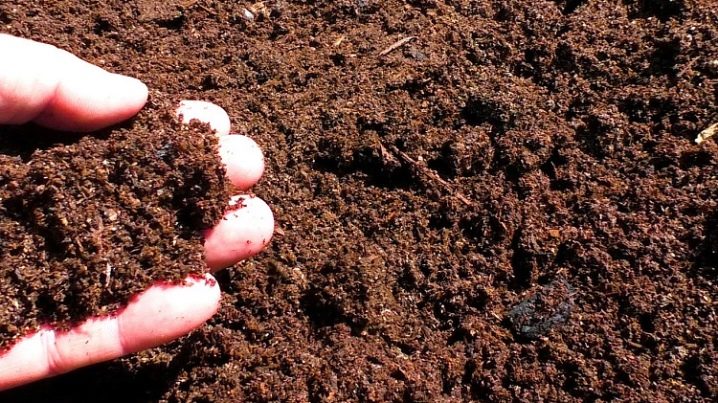
Reproduction
Volzhanka breeding can be done in several ways, each of which has its own characteristic features. Let's take a closer look at each of them.
- By dividing the bush. For this method, only adult plants are suitable, the age of which is 5-7 years; for younger and older specimens, the procedure may be unsafe. It is necessary to pick up such a part of the bush so that after dividing several buds remain on it, and there is also a good root system. The division is carried out using the sharp end of a shovel, after which the sections must be sprinkled with ash or sulfur, and then immediately plant the divisions in the ground, observing all the planting rules.
- Cuttings. This method is much easier to divide and is not only suitable for mature plants. With the help of any sharp instrument, it is necessary to separate the tops of the shoots at least 15-20 cm long.Then you need to put the cutting in water, plant it in a greenhouse or place it in wet sand, and after the roots have formed, you can start the planting process. Volzhanka can be propagated by cuttings throughout the summer.
- With the help of seeds. This method allows the plant to propagate without harming it by any external mechanical effect. The seeds can be purchased at any garden supply store, or harvested from bushes after flowering. They are first sown at home during late winter or early spring. For this, seeds are superficially distributed in a container with soil, after abundant watering they are covered with a film. When the first shoots appear, it can be removed, and after the formation of stable strong seedlings, you can start transplanting into street soil.

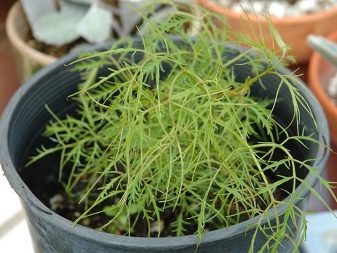
Diseases and pests
Volzhanka is distinguished by strong immunity, which makes the plant resistant to various diseases and pests. Insignificant, but noticeable harm can only be caused by sawfly caterpillars eating the foliage of the plant. Fortunately, this problem is solved by foliar treatment and prophylaxis through root dressing.
Use in landscape design
- Thanks to the fluffy foliage, Volzhanka can become a decoration of the garden not only during the flowering period, but also before it begins, as well as after its completion. Also, due to the spreading foliage, the bushes look great as single plantings, so it is not at all necessary to make massive plantings.
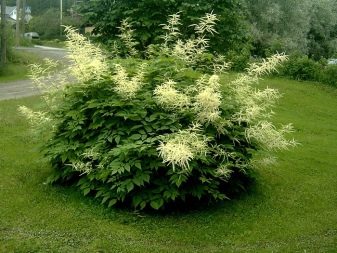

- Low-growing species are perfect for decorating flower beds, and will also become a wonderful decoration of the space along the fence: both on the site and outside.
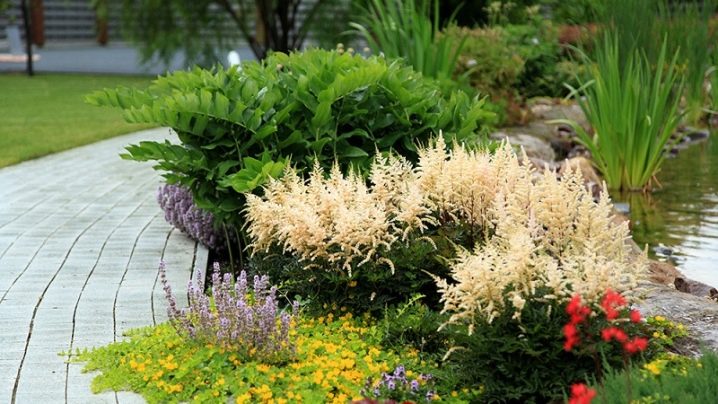
- In some cases, Volzhanka can be combined with other plants, avoiding close contact. For such purposes, fern and delphinium are best suited.
Also, very often dried branches and flowers of Volzhanka are used to create herbaria and decorate a summer veranda or gazebo.
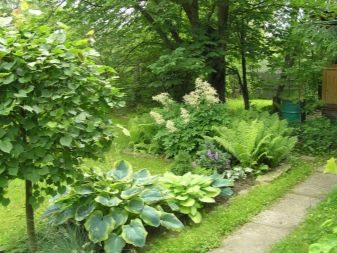
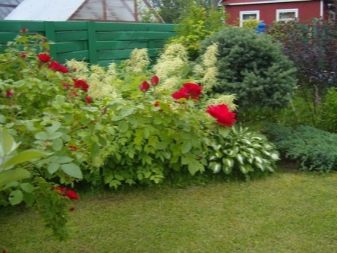













The comment was sent successfully.